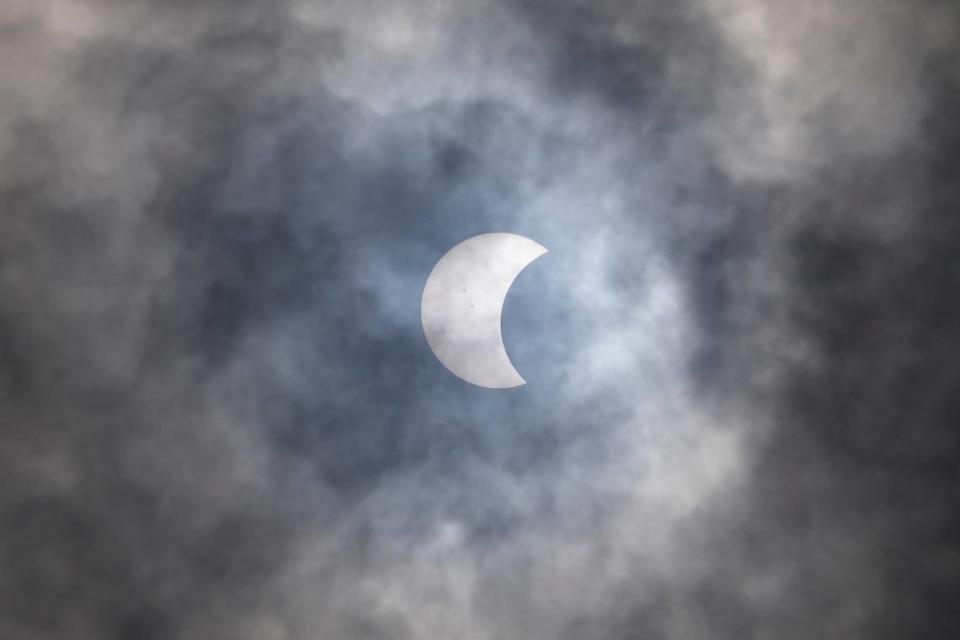Rare solar eclipse wows viewers — and scares birds — in Australia. Take a look
A rare solar eclipse passed over Australia and southeast Asia, stunning skygazers and panicking birds along the way.
The hybrid solar eclipse started in the Indian Ocean around sunrise, crossed western Australia, Timor-Leste and Indonesia before ending in the Pacific Ocean, according to a fact sheet from the Astronomical Society of Australia.
The partial eclipse was visible for about three hours beginning just after 10 a.m. local time Thursday, April 20. The total eclipse was much shorter and lasted only about one minute, according to the Australian Department of Industry, Science and Resources.
The path of totality — the area where the total eclipse is visible — passed over western Australia’s Ningaloo region, according to local authorities. The small town of Exmouth was “the only town within the line of totality,” officials said. Visitors flocked to Exmouth to see the “extraordinary” sight.
Nature filmmaker Chris Lewis captured the scene along the Exmouth Gulf as the total eclipse began. Video shared on Twitter shows the sky darkening within a minute, quickly changing from sunny to dusk-like.
Here is the solar eclipse in real time from the Exmouth Gulf. #SolarEclipse2023 pic.twitter.com/5A583Z2E8u
— Chris Lewis (@a_film_maker) April 20, 2023
Solar eclipses occur when the moon passes between Earth and the Sun, casting a shadow across the Earth. When the moon only blocks out some of the Sun, this is called a partial eclipse. When the moon blocks out the entire Sun, this is called a total eclipse. Viewers will see a different type of eclipse depending on when and where they are watching.
A composite photo from Terra Australis shows each stage of this progression.

Another viewer filmed the total eclipse, a video shared by CBS News on Twitter shows.
“Oh my goodness it’s getting so dark,” the person said in the video. “We have totality. Can you hear the birds? They are going crazy.”
In the background, the frantic and panicked screeches of birds can be heard.
The Western Australia Tourism Department explained that “animals may change their behaviour” during the total eclipse. At the same time, the “air temperature drops” and “some stars and planets become visible,” officials said.
A glowing dark orb emerged over Exmouth, Australia, on Thursday as a total solar eclipse hit totality and sent birds in a frenzy. pic.twitter.com/LpZU4Gz4lV
— CBS News (@CBSNews) April 20, 2023
The hybrid solar eclipse was also visible from Jakarta, Indonesia, where it was a partial eclipse. Photos show the almost-ominous sight of the partially obscured sun shining through the clouds.

Hybrid solar eclipses are a very rare type of eclipse that occur “once every 10 years,” according to the Australian Department of Industry, Science and Resources.
The term “hybrid” refers to the path of the eclipse. Hybrid eclipses cannot “be observed at any point along the path,” according to the Astronomical Society of Australia.
Satellite footage shared on Twitter by Earth Shaker PH shows what the eclipse looked like from space. The shadow appears reddish-black and covers a portion of Australia, Indonesia and the ocean.
LOOK: Amazing sight of "dimming" during a Hybrid Solar Eclipse that started from W. Australia from JMA Himawari 9 satellite's perspective.#SolarEclipse2023 #GAM pic.twitter.com/sou91GPOeF
— Earth Shaker PH (@earthshakerph) April 20, 2023
The next solar eclipse visible in the U.S. will take place Oct. 14, according to NASA. During this event, a partial eclipse “will be visible in all 48 contiguous U.S. states plus Alaska.”
‘Bewildered’ photographer spots freaky spiral gliding through Alaska’s northern lights
Giant space doughnut? New NASA mapping reveals longstanding mysteries of iconic nebula
Videos show cluster of fireballs flew over Florida. It was not a meteor, experts say

